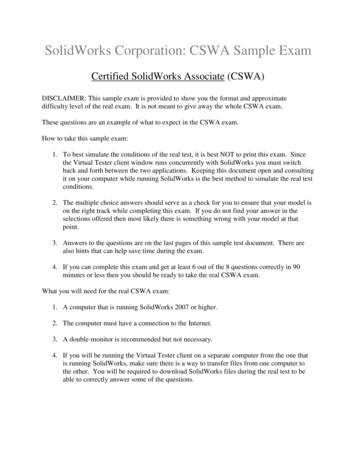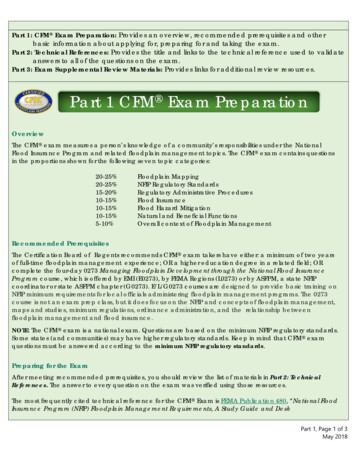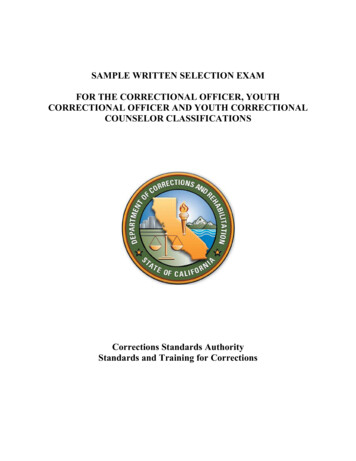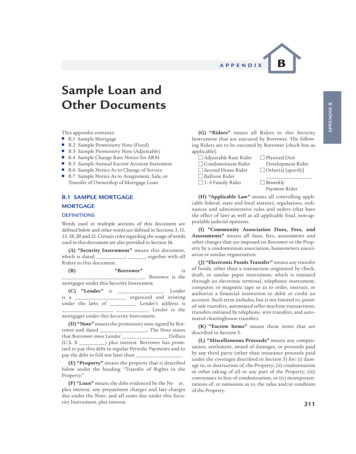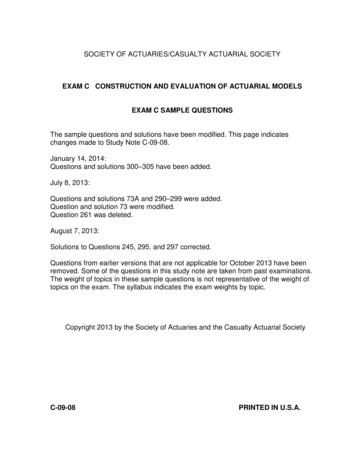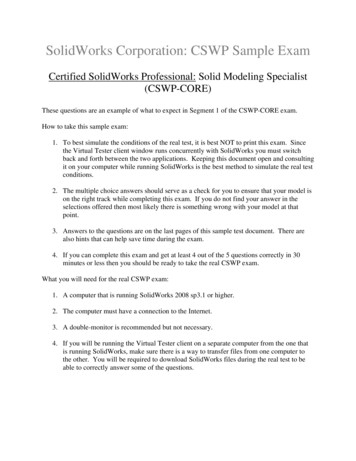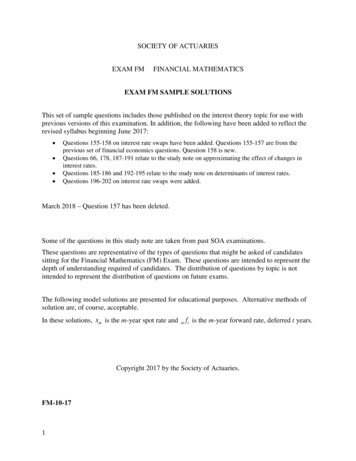
Transcription
SOCIETY OF ACTUARIESEXAM FMFINANCIAL MATHEMATICSEXAM FM SAMPLE SOLUTIONSThis set of sample questions includes those published on the interest theory topic for use withprevious versions of this examination. In addition, the following have been added to reflect therevised syllabus beginning June 2017: Questions 155-158 on interest rate swaps have been added. Questions 155-157 are from theprevious set of financial economics questions. Question 158 is new.Questions 66, 178, 187-191 relate to the study note on approximating the effect of changes ininterest rates.Questions 185-186 and 192-195 relate to the study note on determinants of interest rates.Questions 196-202 on interest rate swaps were added.March 2018 – Question 157 has been deleted.Some of the questions in this study note are taken from past SOA examinations.These questions are representative of the types of questions that might be asked of candidatessitting for the Financial Mathematics (FM) Exam. These questions are intended to represent thedepth of understanding required of candidates. The distribution of questions by topic is notintended to represent the distribution of questions on future exams.The following model solutions are presented for educational purposes. Alternative methods ofsolution are, of course, acceptable.In these solutions, sm is the m-year spot rate andf is the m-year forward rate, deferred t years.m tCopyright 2017 by the Society of Actuaries.FM-10-171
1.Solution: CGiven the same principal invested for the same period of time yields the same accumulatedvalue, the two measures of interest i (2) 0.04 and δ must be equivalent, which means:2 i (2) eδ over a one-year period. Thus, 1 2 2 i (2) 1.022 1.0404e 1 2 δ ln(1.0404) 0.0396.δ2.Solution: EFrom basic principles, the accumulated values after 20 and 40 years are(1 i ) 4 (1 i ) 24100[(1 i ) (1 i ) (1 i ) ] 1001 (1 i ) 420164(1 i ) 4 (1 i ) 44100[(1 i ) (1 i ) (1 i ) ] 100.1 (1 i ) 440364The ratio is 5, and thus (setting x (1 i ) 4 )5 (1 i ) 4 (1 i ) 44 x x11 (1 i ) 4 (1 i ) 24 x x 65 x 5 x 6 x x115 5 x5 1 x100x10 5 x 5 4 ( x 5 1)( x5 4) 0.Only the second root gives a positive solution. Thusx5 4x 1.31951X21.31951 1.3195111 6195.1001 1.31951
Annuity symbols can also be used. Using the annual interest rate, the equation is100s40a4 5(100)s20a4(1 i ) 40 1(1 i ) 20 1 5ii4020(1 i ) 5(1 i ) 4 0(1 i ) 20 4and the solution proceeds as above.3.Solution: C15iiEric’s (compound) interest in the last 6 months of the 8th year is 100 1 .2 2 iMike’s (simple) interest for the same period is 200 .2Thus,15i ii 100 1 200 2 2 215i 2 1 2 i1 1.0472942i 0.09459 9.46%.4.Solution: AThe periodic interest is 0.10(10,000) 1000. Thus, deposits into the sinking fund are 1627.451000 627.45.Then, the amount in sinking fund at end of 10 years is 627.45s10 0.14 12,133 . After repaying theloan, the fund has 2,133, which rounds to 2,130.3
5.Solution: EThe beginning balance combined with deposits and withdrawals is 75 12(10) – 5 – 25 – 80 –35 50. The ending balance of 60 implies 10 in interest was earned.The denominator is the average fund exposed to earning interest. One way to calculate it is toweight each deposit or withdrawal by the remaining time:0 10652 11 1075(1) 10 5 25 80 35 90.833.12 12122412 12 12The rate of return is 10/90.833 0.11009 11.0%.6.Solution: Cnv n 1in a nv nv n 1 v n ii anv n 1 nv n 1 n iiinan 1 v1 vn ii20.011025n0.85003 1 v 77.1 v ( Ia )n 1.105 n 0.14997ln(0.14997) n 19.ln(1.105)To obtain the present value without remembering the formula for an increasing annuity, considerthe payments as a perpetuity of 1 starting at time 2, a perpetuity of 1 starting at time 3, up to aperpetuity of 1 starting at time n 1. The present value one period before the start of each(1/ i )an .perpetuity is 1/i. The total present value is (1/ i )(v v 2 v n ) 4
7.Solution: CThe interest earned is a decreasing annuity of 6, 5.4, etc. Combined with the annual deposits of100, the accumulated value in fund Y is6( Ds )10 0.09 100 s10 0.09 10 (1.09 )10 s 10 0.09 100 (15.19293)6 0.09 565.38 1519.29 2084.67.8.Deleted9.Solution: DFor the first 10 years, each payment equals 150% of interest due. The lender charges 10%,therefore 5% of the principal outstanding will be used to reduce the principal.At the end of 10 years, the amount outstanding is 1000 (1 0.05 ) .598.7410Thus, the equation of value for the last 10 years using a comparison date of the end of year 10 is598.74 Xa 6.1446 X10 10%X 97.44.10.Solution: BThe book value at time 6 is the present value of future payments:BV6 10, 000v 4 800a4 0.06 7920.94 2772.08 10, 693.The interest portion is 10,693(0.06) 641.58.11.Solution: AThe value of the perpetuity after the fifth payment is 100/0.08 1250. The equation to solve is:1250 X (v 1.08v 2 1.0824 v 25 ) X (v v v ) X (25) /1.08 X 50(1.08) 54.5
12.Solution: CEquation of value at end of 30 years:10(1 d / 4) 40 (1.03) 40 20(1.03)30 10010(1 d / 4) 40 [100 20(1.03)30 ] /1.0340 15.7738 1/401 0.98867d / 4 1.57738 4(1 0.98867) 0.0453 4.53%.d 13.Solution: E t ( s 2 /100)ds exp(t 3 / 300).The accumulationfunction is a (t ) exp 0 The accumulated value of 100 at time 3 is 100 exp(33 / 300) 109.41743.The amount of interest earned from time 3 to time 6 equals the accumulated value at time 6minus the accumulated value at time 3. ThusX(109.41743 X ) [a(6) / a(3) 1] (109.41743 X )(2.0544332 /1.0941743 1) X(109.41743 X )0.877613 X96.026159 0.122387 XX 784.61.14.Solution: A (1 k ) 167.50 10a5 9.2% 10(1.092) t 1 1.092 (1 k ) /1.092167.50 38.86955 6.44001 1 (1 k ) /1.092(167.50 38.86955)[1 (1 k ) /1.092] 6.44001(1 k ) /1.092 5 128.63045 135.07046(1 k ) /1.0921 k 1.0399k 0.0399 K 3.99%. 6t
15.Solution: BOption 1: 2000 Pa10 0.0807299 Total payments 2990P Option 2: Interest needs to be 2990 2000 990990 i[2000 1800 1600 200] 11, 000ii 0.09 9.00%16.Solution: BMonthly payment at time t is 1000(0.98)t 1 .Because the loan amount is unknown, the outstanding balance must be calculated prospectively.The value at time 40 months is the present value of payments from time 41 to time 60: OB40 1000[0.9840 v1 0.9859 v 20 ]0.9840 v1 0.9860 v 21 1000, v 1/ (1.0075)1 0.98v0.44238 0.25434 6888.10001 0.9727017.Solution: CThe equation of value is98S3n 98S 2 n 8000(1 i )3n 1 (1 i ) 2 n 1 81.63ii(1 i )n 28 1 4 1 81.63ii10 81.63ii 12.25%7
18.Solution: BConvert 9% convertible quarterly to an effective rate of j per month: 0.09 (1 j )3 1 or j 0.00744.4 Thena 60 0.00744 60v 6048.6136 38.4592 2( Ia )60 0.00744 2 2 2729.7.0.007440.0074419.Solution: CFor Account K, the amount of interest earned is 125 – 100 – 2X X 25 – X.The average amount exposed to earning interest is 100 – (1/2)X (1/4)2X 100. Theni 25 X100 .For Account L, examine only intervals separated by deposits or withdrawals. Determine theinterest for the year by multiplying the ratios of ending balance to beginning balance. Then i125 105.8 1.100 125 XSetting the two equations equal to each other and solving for X,25 X13, 225 1100100(125 X )(25 X )(125 X ) 13, 225 100(125 X )23,125 150 X X 13, 225 12,500 100 XX 2 250 X 2, 400 0X 10.Then i (25 – 10)/100 0.15 15%.8
20.Solution: AEquating present values:100 200v n 300v 2 n 600v10100 200(0.76) 300(0.76) 2 600v10425.28 600v100.7088 v100.96617 v1.03501 1 i i 0.035 3.5%.21.Solution: AThe accumulation function is:1t8 tln ( 8 r ) 0 0 8 r dr a (t ) e e .8tUsing the equation of value at end of 10 years:20, 000 (8k tk )100 180k k22.1010a (10)18 / 8dt k (8 t )dt k 18dt00a (t )(8 t ) / 820, 000 111.180Solution: DLet C be the redemption value and v 1 / (1 i ) . Then X 1000ra2 n i Cv 2 n1 v2n 1000r 381.50i 1000(1.03125)(1 0.58892 ) 381.50 1055.11.23.Solution: DEquate net present values: 4000 2000v 4000v 2 2000 4000v Xv 24000 X2000 6000 1.211.1X 5460.9
24.Solution: EFor the amortization method, the payment is determined by 20, 000 Xa 11.0185, X 1815.13.20 0.065For the sinking fund method, interest is 0.08(20,000) 1600 and total payment is given as X, thesame as for the amortization method. Thus the sinking fund deposit X – 1600 1815.13 – 1600 215.13.The sinking fund, at rate j, must accumulate to 20,000 in 20 years. Thus, 215.13s20 j 20, 000 ,which yields (using calculator) j 14.18%.25.Solution: DThe present value of the perpetuity X/i. Let B be the present value of Brian’s payments. B Xa0.4nXi0.4an 0.4 1 v n v n 0.6iXK v2niXK 0.36 ,iThus the charity’s share is 36% of the perpetuity’s present value.26.Solution: DThe given information yields the following amounts of interest paid: 0.12 10 Seth 5000 1 1 8954.24 5000 3954.24 2 Janice 5000(0.06)(10) 3000.005000Lori P(10) 5000 1793.40 where P 679.35a10 6%The sum is 8747.64.10
27.Solution: E 100[(1 i )11 (1 i )10 ] 100(1 i)10 i . Similarly, for Robbie, X 50(1 i )16 iFor Bruce, X 1 0.5(1 i )6 which implies.Dividing the second equation by the first gives10 (0.122462) 38.879.i 21/6 1 0.122462 . Thus X 100(1.122462)28.Solution: DYear t interest is ian t 1i 1 v n t 1 .v n t .Year t 1 principal repaid is 1 (1 v n t ) X 1 v n t 1 v n t 1 v n t (1 v) 1 v n t d .29.Solution: BFor the first perpetuity,32 10(v 3 v 6 ) 10v 3 / (1 v 3 )32 32v 3 10v 3v 3 32 / 42.For the second perpetuity,X v1/3 v 2/3 v1/3 / (1 v1/3 ) (32 / 42)1/9 / [1 (32 / 42)1/9 ] 32.599.30.Solution: DUnder either scenario, the company will have 822,703(0.05) 41,135 to invest at the end of eachof the four years. Under Scenario A these payments will be invested at 4.5% and accumulate to 41,135s4 0.045 41,135(4.2782) 175,984. Adding the maturity value produces 998,687 for a lossof 1,313. Note that only answer D has this value.The Scenario B calculation is41,135s4 0.055 41,135(4.3423) 178, 621 822, 703 1, 000, 000 1,324.31.Solution: D.The present value is5000[1.07v 1.07 2 v 2 1.07 20 v 20 ]1.07v 1.07 21 v 211.01905 1.48622 5000 122, 617.50001 1.07v1 1.0190511
32. Solution: C.The first cash flow of 60,000 at time 3 earns 2400 in interest for a time 4 receipt of 62,400.Combined with the final payment, the investment returns 122,400 at time 4. The present value is122, 400(1.05) 4 100, 699. The net present value is 699.33.Solution: B.Using spot rates, the value of the bond is:60 / 1.07 60 / 1.082 1060 / 1.093 926.03.34.Solution: E.Using spot rates, the value of the bond is:60 / 1.07 60 / 1.082 1060 / 1.093 926.03. The annual effective rate is the solution to 3926.03 60a3 i 1000(1 i ) . Using a calculator, the solution is 8.9%.35.Solution: C.Duration is the negative derivative of the price multiplied by one plus the interest rate anddivided by the price. Hence, the duration is –(–700)(1.08)/100 7.56.36.Solution: CThe size of the dividend does not matter, so assume it is 1. Then the duration is tvt 1 vt t( Ia ) a / i 1/ (di ) 1 1.1 11.1/ i1/ ia d 0.1t 137.Solution: B tvt Rt tv t 1.02t ( Ia ) a j / j 1 j t 1 t 1 . a j1/ jdtttv Rtv 1.02 11ttDuration 11.02 v 1.02 /1.05 j 0.03 /1.02. Then the duration isThe interest rate j is such that (1 j ) 1/ d (1 j ) / j (1.05 / 1.02) / (0.03 / 1.02) 1.05 / 0.03 35.12
45.Solution: AFor the time weighted return the equation is:1 0 12 X 120 10 X 12 X 120 2 X X 60.10 12 XThen the amount of interest earned in the year is 60 – 60 – 10 –10 and the weighted amountexposed to earning interest is 10(1) 60(0.5) 40. Then Y –10/40 –25%.46.Solution: AThe outstanding balance is the present value of future payments. With only one future payment,that payment must be 559.12(1.08) 603.85. The amount borrowed is 603.85a4 0.08 2000. Thefirst payment has 2000(0.08) 160 in interest, thus the principal repaid is 603.85 – 160 443.85.Alternatively, observe that the principal repaid in the final payment is the outstanding loanbalance at the previous payment, or 559.12. Principal repayments form a geometricallydecreasing sequence, so the principal repaid in the first payment is 559.12 / 1.083 443.85.47.Solution: BBecause the yield rate equals the coupon rate, Bill paid 1000 for the bond. In return he receives30 every six months, which accumulates to 30 s20 j where j is the semi-annual interest rate. Theequation of value is 1000(1.07)10 30 s20 j 1000 s20 j 32.238. Using a calculator to solve for2the interest rate produces j 0.0476 and so i 1.0476 1 0.0975 9.75%.48.Solution: ATo receive 3000 per month at age 65 the fund must accumulate to 3,000(1,000/9.65) 300 0.08/12 957.36657 X 324.72.310,880.83. The equation of value is 310,880.83 Xs 49.Solution: D(A) The left-hand side evaluates the deposits at age 0, while the right-hand side evaluates thewithdrawals at age 17.(B) The left-hand side has 16 deposits, not 17.(C) The left-hand side has 18 deposits, not 17.(D) The left-hand side evaluates the deposits at age 18 and the right-hand side evaluates thewithdrawals at age 18.(E) The left-hand side has 18 deposits, not 17 and 5 withdrawals, not 4.13
50. Deleted51. Solution: DBecause only Bond II provides a cash flow at time 1, it must be considered first. The bondprovides 1025 at time 1 and thus 1000/1025 0.97561 units of this bond provides the requiredcash. This bond then also provides 0.97561(25) 24.39025 at time 0.5. Thus Bond I mustprovide 1000 – 24.39025 975.60975 at time 0.5. The bond provides 1040 and thus975.60975/1040 0.93809 units must be purchased.52. Solution: CBecause only Mortgage II provides a cash flow at time two, it must be considered first. Themortgage provides Y / a2 0.07 0.553092Y at times one and two. Therefore, 0.553092Y 1000for Y 1808.02. Mortgage I must provide 2000 – 1000 1000 at time one and thus X 1000/1.06 943.40. The sum is 2751.42.53. Solution: ABond I provides the cash flow at time one. Because 1000 is needed, one unit of the bond shouldbe purchased, at a cost of 1000/1.06 943.40.Bond II must provide 2000 at time three. Therefore, the amount to be reinvested at time two is2000/1.065 1877.93. The purchase price of the two-year bond is 1877.93 / 1.07 2 1640.26 .The total price is 2583.66.54. Solution: CGiven the coupon rate is greater than the yield rate, the bond sells at a premium. Thus, theminimum yield rate for this callable bond is calculated based on a call at the earliest possibledate because that is most disadvantageous to the bond holder (earliest time at which a lossoccurs). Thus, X, the par value, which equals the redemption value because the bond is a parvalue bond, must satisfyPrice 301722.25 0.04 Xa30 0.03 Xv 1.196 X X 1440.0.0355. Solution: BBecause 40/1200 is greater than 0.03, for early redemption the earliest redemption should be1278.40 . If the bondevaluated. If redeemed after 15 years, the price is 40a30 0.03 1200 /1.0330 1261.80 . The smallest value shouldis redeemed at maturity, the price is 40a40 0.03 1100 /1.0340 be selected, which is 1261.80.14
56. Solution: EGiven the coupon rate is less than the yield rate, the bond sells at a discount. Thus, the minimumyield rate for this callable bond is calculated based on a call at the latest possible date becausethat is most disadvantageous to the bond holder (latest time at which a gain occurs). Thus, X, thepar value, which equals the redemption value because the bond is a par value bond, must satisfyPrice 201021.50 0.02 Xa20 0.03 Xv0.030.851225 X X 1200.57. Solution: BGiven the price is less than the amount paid for an early call, the minimum yield rate for thiscallable bond is calculated based on a call at the latest possible date. Thus, for an early call, theeffective yield rate per coupon period, j, must satisfy Price 1021.50 22a19 j 1200v19j . Usingthe calculator, j 2.86%. We also must check the yield if the bond is redeemed at maturity. Theequation is 1021.50 22a20 j 1100v 20j . The solution is j 2.46% Thus, the yield, expressed as anominal annual rate of interest convertible semiannually, is twice the smaller of the two values,or 4.92%.58. Moved to Derivatives section59. Solution: CFirst, the present value of the liabilityis PV 35,000a15 6.2% 335,530.30. The duration of the liability is:tv R v Rtd ttt35, 000v 2(35, 000)v 2 15(35, 000)v15 2,312,521.95 6.89214.335,530.30335,530.30Let X denote the amount invested in the 5 year bond.XX (5) 1 6.89214 X 208,556. (10) 335,530.30335,530.30 Then,15
60. Solution: AThe present value of the first eight payments is:2000v 2000(1.03)8 v9PV 2000v 2000(1.03)v . 2000(1.03) v 13,136.41.1 1.03v27 8The present value of the last eight payments is: PV 2000(1.03)7 0.97v 9 2000(1.03)7 (0.97) 2 v10 2000(1.03)7 (0.978 )v162000(1.03)7 0.97v 9 2000(1.03)7 (0.97)9 v17 7,552.22.1 0.97vTherefore, the total loan amount is L 20,688.63.61.Solution: E r2 t 2000 500 exp 1003 dr 0 r 3 150 r2t 3 tr50 dr exp 0.5ln 3 4 exp 0.5 3 0 150 r 0 3 150 12 t 3 t3 4 exp 0.5ln 1 1 450 450 t3 16 1 450 t 18.898862.Solution: ELet F, C, r, and i have their usual interpretations. The discount is (Ci Fr )an and the discount inthe coupon at time t is (Ci Fr )v n t 1 . Then, (Ci Fr )v 26194.82 (Ci Fr )v 21306.690.63523 v5 v 0.91324 i 0.09526 (Ci Fr ) 194.82(1.095)2062.53 a40 0.095 21,135Discount 2062.5316
63.Solution: A699.68 Pv8 5 1P 842.39 (annual payment)699.68P1 581.14 1.04754I1 842.39 581.14 261.25261.25 5500 (loan amount)0.0475Total interest 842.39(8) 5500 1239.12L 64.Solution: DOB18 22, 000(1.007)18 450.30 s18 0.007 16,337.1016,337.10 Pa24 0.004P 715.2765.Solution: CIf the bond has no premium or discount, it was bought at par so the yield rate equals the couponrate, 0.038.(11(190)v 2(190)v 2 14(190)v14 14(5000)v142d 190v 190v 2 190v14 5000v14d )95 ( Ia )14 7(5000)v14190a14 5000v14d 5.5554Or, taking advantage of a shortcut: d a 11.1107. This is in half years, so dividing by two, d14 0.03866.Solution: A7.959 7.4251.072 P(0.08) P(0.072) [1 ( i )v ] vP(0.08) 1000 [1 (0.008)(7.425) ] 940.601711.1107 5.5554 .2
67.Solution: E(1 s3 )3 (1 s2 ) 2 (1 1 f 2 )0.85892 1, s3 0.052 (1 s3 )30.90703 1, s2 0.050 (1 s2 ) 21.0523 1.0502 (1 1 f 2 ) 1 f268. 0.056Solution: CLet d 0 be the Macaulay duration at time 0.6.7864d0 a 8 0.05d1 d0 1 5.78646.0757d 2 a 7 0.05d1 5.7864 0.9524d 2 6.0757This solution employs the fact that when a coupon bond sells at par the duration equals thepresent value of an annuity-due. For the duration just before the first coupon the cash flows arethe same as for the original bond, but all occur one year sooner. Hence the duration is one yearless.Alternatively, note that the numerators for d1 and d 2 are identical. That is because they differonly with respect to the coupon at time 1 (which is time 0 for this calculation) and so thepayment does not add anything. The denominator for d 2 is the present value of the same bond,but with 7 years, which is 5000. The denominator for d1 has the extra coupon of 250 and so is5250. The desired ratio is then 5000/5250 0.9524.69.Solution: ALet N be the number of shares bought of the bond as indicated by the subscript. N NC 0.9524C (105) 100,N B (100) 102 0.9524(5), N B 0.9724N A (107) 99 0.9524(5), N A 0.880718
19
70.Solution: BAll are true except B. Immunization requires frequent rebalancing.71.Solution: DSet up the following two equations in the two unknowns:A(1.05) 2 B(1.05) 2 60002 A(1.05)1 2 B(1.05) 3 0.Solving simultaneously gives:A 2721.09B 3307.50A B 586.41.72.Solution: ASet up the following two equations in the two unknowns.(1) 5000(1.03)3 B(1.03) b 12, 000 5463.635 B(1.03) b 12, 000 B(1.03) b 6536.365(2) 3(5000)(1.03)3 bB(1.03) b 0 16,390.905 b6536.365 0b 2.5076B 7039.27B 2807.12b20
73.Solution: DPA A(1 i ) 2 B(1 i ) 9PL 95, 000(1 i ) 5 PA′ 2 A(1 i ) 3 9 B(1 i ) 10PL′ 5(95, 000)(1 i ) 6Set the present values and derivatives equal and solve simultaneously.0.92456 A 0.70259 B 78, 083 1.7780 A 6.0801B 375, 40078, 083(1.7780 / 0.92456) 375, 400B 47, 6300.70259(1.7780 / 0.92456) 6.0801A [78, 083 0.70259(47, 630)] / 0.92456 48, 259A 1.0132B74.Solution: DThroughout the solution, let j i/2.For bond A, the coupon rate is (i 0.04)/2 j 0.02.For bond B, the coupon rate is (i – 0.04)/2 j – 0.02.The price of bond A is PA 10, 000( j 0.02)a20 j 10, 000(1 j ) 20 .The price of bond B is PB 10, 000( j 0.02)a20 j 10, 000(1 j ) 20 .Thus,PA P [200 ( 200)]a20 5,341.12400a20 jBj a20 j 5,341.12/ 400 13.3528.Using the financial calculator, j 0.042 and i 2(0.042) 0.084.21
75.Solution: DThe initial level monthly payment isR 400, 000 400, 000 4, 057.07.a15 12 0.09/12 a180 0.0075The outstanding loan balance after the 36th payment is 356, 499.17.B36 Ra4, 057.07a144 0.0075 4, 057.07(87.8711)180 36 0.0075The revised payment is 4,057.07 – 409.88 3,647.19.Thus,356, 499.17 3, 647.19a144 j /12499.17 / 3, 647.19 97.7463.a144 j /12 356, Using the financial calculator, j/12 0.575%, for j 6.9%.76.Solution: DThe price of the first bond is1000(0.05 / 2)a30 2 0.05/2 1200(1 0.05 / 2) 30 2 25a60 0.025 1200(1.025) 60 772.72 272.74 1, 045.46.The price of the second bond is also 1,045.46. The equation to solve is1, 045.46 25a60 j /2 800(1 j / 2) 60 .The financial calculator can be used to solve for j/2 2.2% for j 4.4%.77.Solution: ELet n years. The equation to solve is1000(1.03) 2 n 2(1000)(1.0025)12 n 12n ln1.0025 ln 20002n ln1.03 ln10000.029155n 0.69315n 23.775.This is 285.3 months. The next interest payment to Lucas is at a multiple of 6, which is 288months.78.Solution: BThe ending balance is 5000(1.09) 2600sqrt(1.09) 8164.48.The time-weighted rate of return is (5200/5000) x [8164.08/(5200 2600)] – 1 0.0886.22
79.Solution: AEquating the accumulated values after 4 years provides an equation in K.4K 1 4 dt 10 1 10 exp 25 0 K 0.25t 4K 114 dt 4 ln(K 0.25 t) 4 ln(1 0.04 K ) 4 ln( K 1) 4 ln( K ) 4 ln00 K 0.25tKK 11 0.04 K K20.04 K 1K 5.10(1 5 / 25) 4 20.74.Therefore, X 80.Solution: CTo repay the loan, the sinking fund must accumulate to 1000. The deposit is 2(1000i). Therefore,1000 2000is5 0.8i(1 0.8i )5 10.8i5(1 0.8i ) 1.40.5 i1 0.8i 1.0696i 0.0696/ 0.8 0.087. 81.Solution: DThe outstanding balance at time 25 is 100( Da ) 25 100payment is X 2500 i (100)25 a2525 a25i. The principle repaid in the 26th 2500 2500 100a25 100a25 . The amount borrowediis the present value of all 50 payments, 2500a25 v 25100( Da ) 25 . Interest paid in the firstpayment is theni 2500a25 v 25100( Da ) 25 2500(1 v 25 ) 100v 25 (25 a25 )2500 2500v 25 2500v 25 v 25100a25 2500 Xv 25 .23
82.Solution: AThe exposure associated with i produces results quite close to a true effective rate of interest aslong as the net amount of principal contributed at time t is small relative to the amount in thefund at the beginning of the period.83.Solution: EThe time-weighted weight of return isj (120,000 / 100,000) x (130,000 / 150,000) x (100,000 / 80,000) – 1 30.00%.Note that 150,000 120,000 30,000 and 80,000 130,000 – 50,000.84.Solution: CThe accumulated value is 1000 s20 0.816 50,382.16. This must provide a semi-annual annuitydue of 3000. Let n be the number of payments. Then solve 3000a n 0.04 50,382.16 for n 26.47. Therefore, there will be 26 full payments plus one final, smaller, payment. The equation is50,382.16 3000a 26 0.04 X (1.04) 26 with solution X 1430. Note that the while the finalpayment is the 27th payment, because this is an annuity-due, it takes place 26 periods after theannuity begins.85.Solution: DFor the first perpetuity,1(1 i )2 1 1 7.2112 (1 i ) 16.21i 0.0775.For the second perpetuity, 117.21R (1.0875) 1 3 (1.0775 0.01) 1 1.286139 R 7.21(1.0875) ( 0.286139 )R 1.74.24
86.Solution: E a 5v 5 10, 000 100( Ia )5 Xv 5 a15 100 5 Xv 5 a15 0.05 10,000 1256.64 8.13273 X1075 X87.Solution: C5000 Xs10 0.06 (1.05)5 X88.5000 297.2213.1808(1.2763)Solution: EThe monthly payment on the original loan is65, 000 621.17 . After 12 payments thea180 8/12%outstanding balance is 621.17 a168 8/12% 62, 661.40 . The revised payment is89.62, 661.40 552.19.a168 6/12%Solution: EAt the time of the final deposit the fund has 750 s18 0.07 25, 499.27. This is an immediateannuity because the evaluation is done at the time the last payments is made (which is the end ofthe final year). A tuition payment of 6000(1.05)17 13, 752.11 is made, leaving 11,747.16. Itearns 7%, so a year later the fund has 11,747.16(1.07) 12,569.46. Tuition has grown to13,752.11(1.05) 14,439.72. The amount needed is 14,439.72 – 12,569.46 1,870.2690.Solution: BThe coupons are 1000(0.09)/2 45. The present value of the coupons and redemption value at5% per semiannual period is P 45a40 0.05 1200(1.05) 40 942.61.91.Solution: AFor a bond bought at discount, the minimum price will occur at the latest possible redemptiondate. P 50a20 0.06 1000(1.06) 20 885.30.25
92.Solution: C1.0955 1 11.5%1.090493.Solution: DThe accumulated value of the first year of payments is 2000 s12 0.005 24, 671.12. This amountincreases at 2% per year. The effective annual interest rate is 1.00512 1 0.061678. Thepresent value is then1 25 1.02 24,671.12 1.02 (1.061678)24, 671.12 1.02 k 1 1.061678 k 1 25Pk 1k k0.960743 0.96074326 374, 444.24,187.371 0.960743This is 56 less than the lump sum amount.94.Solution: AThe monthly interest rate is 0.072/12 0.006. 6500 five years from today has value6500(1.006) 60 4539.77 . The equation of value is4539.77 1700(1.006) n 3400(1.006) 2 n . Let x 1.006 n . Then, solve the quadratic equation3400 x 2 1700 x 4539.77 0x 1700 17002 4(3400)( 4539.77) 0.93225.2(3400)Then, n1.006 0.9325 n ln(1.006) ln(0.93225) n 11.73.To ensure there is 6500 in five years, the deposits must be made earlier and thus the maximumintegral value is 11.26
95.Solution: C(1 d 2 ) 39 4 1 d 4(1 d / 4 ) 38 1 dd ( 39 2 38 4 ) 39 38 42 38 39 39(d 2) 38 38(d 4)4 39 0.1d 1/ (19.5 9.5)1 i (1 d / 2 )96. 2 .95 2 1.108 i 10.8%.Solution: CThe monthly interest rate is 0.042/12 0.0035. The quarterly interest rate is 1.00353 1 0.0105. The investor makes 41 quarterly deposits and the ending date is 124 months from the start.Using January 1 of year y as the comparison date produces the following equation:411001.9 X k1.0035124k 1 1.0105X Substituting 1.0105 1.00353 gives answer (C).97.Solution: DConvert the two annual rates, 4% and 5%, to two-year rates as 1.042 1 0.0816 and1, 052 1 0.1025 .The accumulated value is100 s3 0.0816 (1.05) 4 100 s2 0.1025 100(3.51678)(1.21551) 100(2.31801) 659.269 .With only five payments, an alternative approach is to accumulate each one to time ten and addthem up.The two-year yield rate is the solution to 100 s5 i 659.269 . Using the calculator, the two-yearrate is 0.093637. The annual rate is 1.093637 0.5 1 0.04577 which is 4.58%.98.Solution: C(1.08)1 12 1 0.006434125, 000ä4 8% Xä216 0.6434%1.081525, 000(3.57710)X 240.383.17217(117.2790)27
99.Solution: B11 1 0.08 0.1 PVperp. (15, 000) 15, 000100.11.1 164, 457.87 15, 000 179, 457.87a 179, 458X a 10 0.10 15 0.08 10 1.10 9.244 179, 458X 6.759 1.1010 X 17,384100.Solution: A a 14(1.03) 14 140.03 300(1.03) 141050.50 (22.50 X )a14 0.03 X 0.03 11.2961 9.25565 1050.50 (22.50 X )11.2961 X 79.3111X 598 X 7.54 198.335 0.03 101.Solution: DThe amount of the loan is the present value of the deferred increasing annuity:(1.05)102. 10 500a 30 0.05 500( Ia )30 (1.05 0.05 10 a 30 0.05 30(1.05) 30 )(500) a 30 0.05 64, 257.0.05 /1.05 Solution: C (1 i )30 (1.03)30 (1 i )30 (1.03)30 50, 000 (1)5,000i 30i 0.03 (1 i ) (i 0.03) 2950, 000 / (1 i ) 5, 000(1 i ) 29 101 0.082637i 101/29 The accumulated amount is (1.082637)30 (1.03)3050, 000 (1.082637) 797,836.8230 (1.082637) (0.082637 0.03) 28
103.Solution: DThe first payment is 2,000, and the second payment of 2,010 is 1.005 times the first payment.Since we are given that the series of quarterly payments is geometric, the payments multiply by1.005 every quarter.Based on the quarterly interest rate, the equation of value is 2, 000 2, 000(1.005)v 2, 000(1.005) 2 v 2 2, 000(1.005)3 v 3 100, 0002, 0001 1.005v . 1 1.005v 2, 000 /100,000 v 0.98 /1.005. 4The annual effective rate is v 1 1( 0.98 /1.005) 40.10601 10.6% .104. Solution: A1 (1.06 )Present value for the first 10 years is 7.58ln (1.06 ) 10Present value of the payments after 10 years is 0.5584 19.45ln (1.06 ) ln (1.03)(1.06 ) 0 (1.03) (1.06 ) ds 10s sTotal present value 27.03105.Solution: C101 10, 000 (1.06 )5 X (1.06 )2 e 5 t 1 75, 000 1175, 000(13,382.26 1.1236 X ) 61.1236 X 27,526.83X 24, 498.78106.dtSolution: DThe effective annual interest rate is i (1
previous set of financial econom ics questions. Question 158 is new. Questions 66, 178, 187-191 relate to the study note on approximating the effect of changes in interest rates. Questions 185-186 and 192-195 relate to the study note on determinants of interest rates. Questions 196-202 on interest rate swaps were added.
